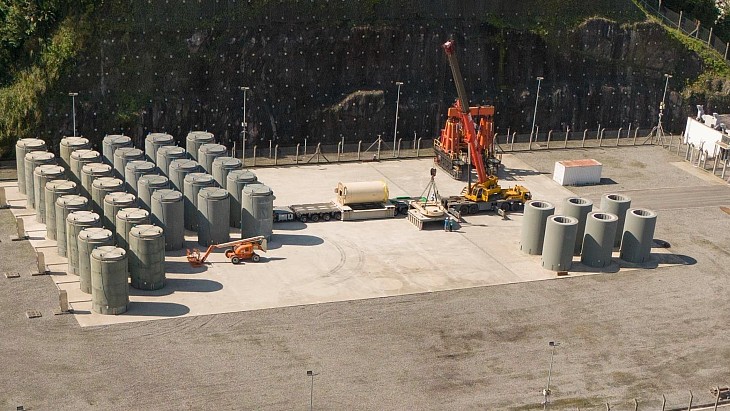Ahead of the start of construction later this year of a full-scale Synroc waste treatment plant, the Australian Nuclear Science and Technology Organization (Ansto) is preparing to upscale the technology from a research level to an industrial scale in a pilot plant.
Synroc (short for synthetic rock) is a suite of technologies developed by Ansto for immobilising various forms of intermediate- and high-level radioactive wastes for disposal. It is a ceramic made from several natural minerals which together incorporate into their crystal structures nearly all of the elements present in high-level radioactive waste. According to Ansto, Synroc can reduce the volume of nuclear by-products by 99% (compared with other methods such as cementation).
.jpg) |
| The thin-walled vessel (left) is filled with a granulated waste form powder that is subsequently compressed into a solid mass by hot isostatic pressing. The can is designed to collapse into a cylindrical shaped vessel (right) for storage. The centre image shows a cross-section of the dense solid waste form that is encapsulated within the thin-wall vessel (Image: Ansto) |
In 2012, the Australian government announced plans for the construction of a nuclear medicine manufacturing plant at Ansto's Lucas Heights site near Sydney, together with a demonstration waste treatment plant based on Synroc technology for managing the subsequent radioactive by-products. Together, the facilities are known as the Ansto Nuclear Medicine (ANM) project.
Construction of the molybdenum-99 (Mo-99) production facility has already started and construction of the Synroc waste treatment plant is set to begin later this year. However, Ansto plans to have a Synroc pilot plant in operation in mid-2016.
Gerry Triani, technical director of the Synroc project, said in a statement yesterday: "We're in the engineering phase, seeking to further develop our process intellectual property on Synroc and move it to an industrial scale demonstration of our technology. Synroc is moving to realise its design concept into a fully functional process plant that will treat intermediate-level waste from the Ansto Nuclear Medicine project."
In the Synroc process, the radioactive liquid waste is first mixed with additives that create a slurry that is then dried to produce a free-flowing powder. The granular powder is thermally treated before it is dispensed into cans where it is sealed. The can is then placed inside a furnace that is contained within a hot isostatic press (HIP), where heat and pressure are applied to lock in the radionuclides. Under these conditions the powdered mixture fuses together to form a solid without releasing any emissions. The can contracts to form a cylindrical shape which is designed for storage efficiency.
Triani said, "In our demonstration facility we are building a fully integrated pilot plant that will replicate the liquid waste being converted to a free-flowing powder, which will form the design inputs for the final plant." He said that Ansto, having worked with smaller models of the storage can during Synroc's development, was also upscaling the can to its final size and shape.
"The next key milestone in the short term is to create a fully integrated process of our front-end in our demonstration plant. We will fill a can using a cascade delivery system to demonstrate the processes as they need to be configured in a hot-cell," Triani said. "The can will then be sealed before transporting it to our current large HIP facility."
He added: "By increasing our technology readiness levels of the process in our demonstration plant, we are essentially de-risking many of the engineering challenges for the waste treatment plant design going forward."
The demonstration of the Synroc technology will show its potential to close the Mo-99 production cycle, he said. "Hopefully this technology will become the benchmark for waste treatment in the production of Mo-99 radiopharmaceuticals."
The Synroc-treated waste will eventually be sent from Lucas Heights to the proposed national radioactive waste management facility, once it has been sited, constructed and licensed.
Researched and written
by World Nuclear News




_58913.jpg)
_35510.jpg)
_93097.jpg)





